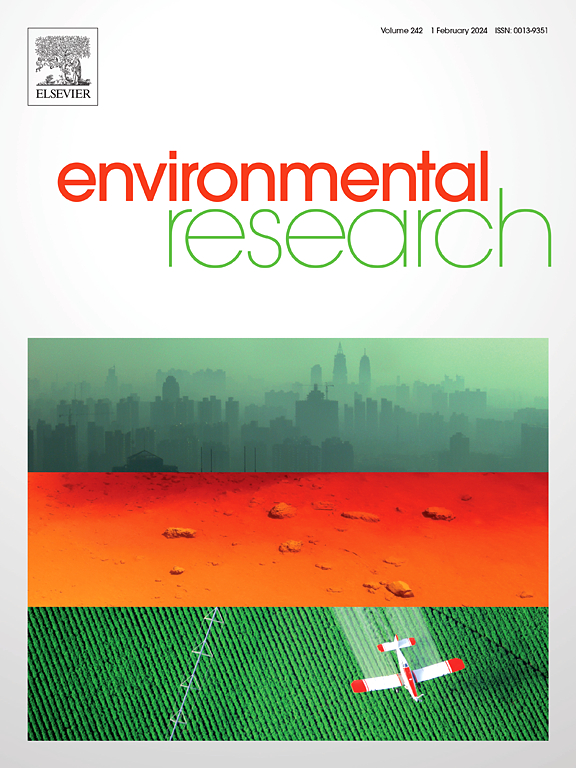全氟烷基和多氟烷基物质暴露与表观遗传年龄之间的性别特异性关联:1999-2000年全国健康和营养检查调查的结果
IF 7.7
2区 环境科学与生态学
Q1 ENVIRONMENTAL SCIENCES
引用次数: 0
摘要
全氟烷基和多氟烷基物质(PFAS)是一类普遍存在的合成化合物,据报道具有广泛的健康影响。表观遗传时钟是基于DNA甲基化的时间和生物年龄预测因子,是表征人类生物衰老的有希望的生物标志物。PFAS暴露对美国普通人群表观遗传衰老的潜在影响尚不清楚。在1999-2000年全国健康与营养调查(NHANES)周期(N = 262)中,用EPICv1阵列测定了血清中11种PFASs和血液中DNA甲基化。计算了7种表观遗传时钟及其相应的表观遗传年龄加速(EAA)措施。采用调查设计加权广义线性回归模型检验按性别分层的个体log2转化PFAS浓度与EAA之间的校正相关性。在男性参与者中,PFNA浓度加倍与多个时钟的EAA增加有关,包括Horvath时钟(beta = 1.48, 95% CI: 0.35, 2.61)、皮肤和血液时钟(beta = 1.27, 95% CI: 0.21, 2.32)和表型年龄(beta = 1.43, 95% CI: 0.41, 2.44), PFOS暴露加倍与皮肤和血液EAA增加有关(beta = 1.14, 95% CI: 0.04, 2.24)。当考虑细胞调整的EAA测量时,男性参与者中的这些关联仍然显著,PFOSA与女性参与者中表型EAA (β = - 0.84, 95% CI: - 1.49, - 0.18)和GrimAge2 EAA (β = - 0.81, 95% CI: - 1.51, - 0.11)的降低相关。总之,我们在一个代表美国普通人群的老年人样本中发现了PFAS暴露与表观遗传衰老之间存在性别特异性关联的证据。本文章由计算机程序翻译,如有差异,请以英文原文为准。
Sex-specific associations between per- and polyfluoroalkyl substance exposure and epigenetic age: Findings from the National Health and Nutrition Examination survey 1999–2000
Per-and polyfluoroalkyl substances (PFAS) are a pervasive family of synthetic compounds with a wide range of reported health effects. Epigenetic clocks, DNA methylation-based predictors of chronological and biological age, are promising biomarkers for characterizing biological aging in humans. The potential impact of PFAS exposure on epigenetic aging in the general US population remains unclear. In the 1999–2000 National Health and Nutrition Examination Survey (NHANES) cycle (N = 262), eleven PFASs were measured in serum and DNA methylation was measured in blood with the EPICv1 array. Seven epigenetic clocks and their respective epigenetic age acceleration (EAA) measures were calculated. Survey-design weighted generalized linear regression models were used to test adjusted associations between individual log2-transformed PFAS concentrations and EAA stratified by sex. Among male participants, doubling of PFNA concentrations was associated with greater EAA across several clocks including the Horvath clock (beta = 1.48, 95 % CI: 0.35, 2.61), Skin&Blood clock (beta = 1.27, 95 % CI: 0.21, 2.32), and PhenoAge (beta = 1.43, 95 % CI: 0.41, 2.44), and doubling of PFOS exposure was associated with greater Skin&Blood EAA (beta = 1.14, 95 % CI: 0.04, 2.24). When considering cell-adjusted EAA measures, each of these associations among male participants remained significant, and PFOSA was associated with decreased PhenoAge EAA (beta = −0.84, 95 % CI: −1.49, −0.18) and GrimAge2 EAA (beta = −0.81, 95 % CI: −1.51, −0.11) among female participants. In summary, we found evidence of sex-specific associations between PFAS exposure and epigenetic aging in a sample of older adults representative of the general US population.
求助全文
通过发布文献求助,成功后即可免费获取论文全文。
去求助
来源期刊

Environmental Research
环境科学-公共卫生、环境卫生与职业卫生
CiteScore
12.60
自引率
8.40%
发文量
2480
审稿时长
4.7 months
期刊介绍:
The Environmental Research journal presents a broad range of interdisciplinary research, focused on addressing worldwide environmental concerns and featuring innovative findings. Our publication strives to explore relevant anthropogenic issues across various environmental sectors, showcasing practical applications in real-life settings.
 求助内容:
求助内容: 应助结果提醒方式:
应助结果提醒方式:


